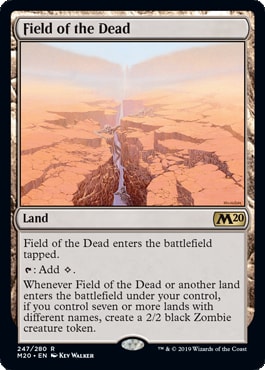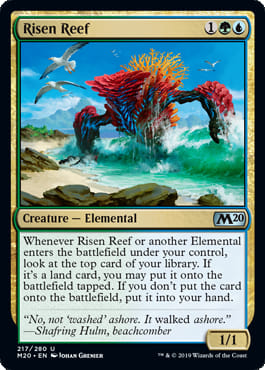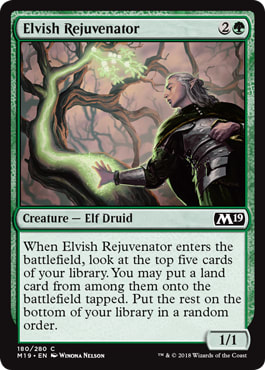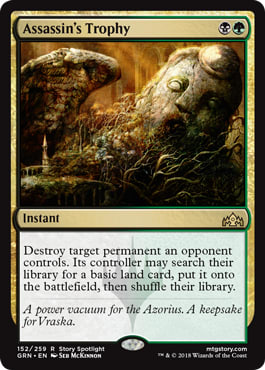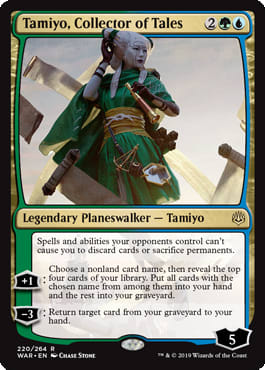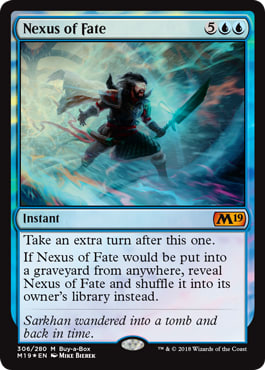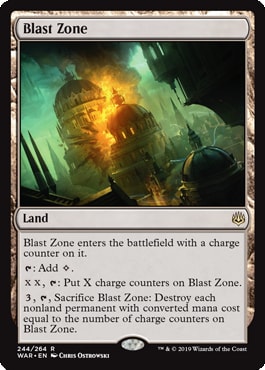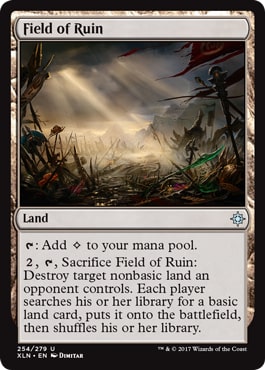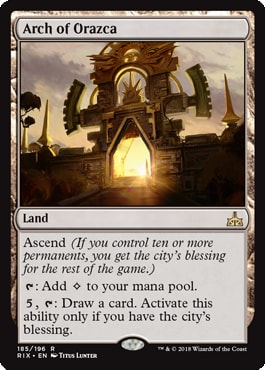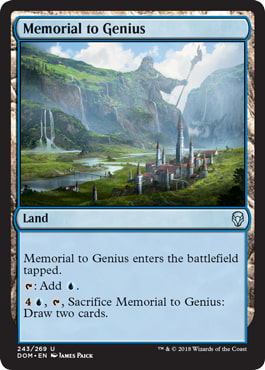Core Set 2020 brought with it a number of cards that impacted Standard, but the most impactful among them are likely the lands. Not only did the Temples bring additional mana fixing and consistency from scrying, but this powerful land has defined entirely new archetypes:
We saw Field of the Dead decks powered by Scapeshift take Grand Prix Denver by storm, but in the weeks that followed these decks felt to me like they fell off in power level some. This is in large part due to the metagame adjusting their answers to better clean up the large burst of zombies Scapeshift generates.
This sent me looking for a more "fair" Field of the Dead deck that was better able to rebuild after all of its zombies were swept away. This search led me to the following decklist:
Yarok Field | Core Set 2020 Standard| Jeff Hoogland
- Creatures (20)
- 4 Arboreal Grazer
- 4 Cavalier of Thorns
- 4 Elvish Rejuvenator
- 4 Risen Reef
- 4 Yarok, the Desecrated
- Planeswalkers (1)
- 1 Tamiyo, Collector of Tales
- Instants (10)
- 1 Nexus of Fate
- 2 Disfigure
- 3 Assassin's Trophy
- 4 Growth Spiral
- Lands (29)
- 1 Forest
- 1 Island
- 1 Swamp
- 1 Arch of Orazca
- 1 Blast Zone
- 1 Dismal Backwater
- 1 Drowned Catacomb
- 1 Field of Ruin
- 1 Jungle Hollow
- 1 Memorial to Genius
- 1 Simic Guildgate
- 1 Thornwood Falls
- 1 Woodland Cemetery
- 2 Breeding Pool
- 2 Hinterland Harbor
- 2 Overgrown Tomb
- 2 Temple of Malady
- 2 Temple of Mystery
- 2 Watery Grave
- 4 Field of the Dead
- Sideboard (15)
- 1 Assassin's Trophy
- 1 Cerulean Drake
- 2 Disfigure
- 3 Noxious Grasp
- 4 Shifting Ceratops
- 4 Unmoored Ego
As the name implies, in addition to Field of the Dead the other key card in this archetype is Yarok, the Desecrated. This is because not only does Yarok double the triggers from creatures entering the battlefield, but all other permanent types as well. This means Yarok makes each Field create two zombies for each land that enters play. Yarok also has reasonable stats to help gum up most boards. His deathtouch lets him trade with larger threats and his lifelink makes him difficult to race.
The core of our deck is our various tools for accelerating additional lands into play:
Arboreal Grazer is easily the best card in our deck against aggressive decks. Not only does it get us ahead on lands, but it also blocks early aggression. The land Grazer puts into play a turn sooner also helps us curve out naturally in spite of our many tapped lands. Growth Spiral is what I like to refer to as a replacement level card. Its effect is something we are interested in, but frequently it is a low power level card that we swap out for something better post board.
Risen Reef is one of the best cards to come out of Core Set 2020. At worst, Risen Reef draws a card and eats a removal spell. At best, Risen Reef creates overwhelming card advantage when paired with other elementals such as Yarok, the Desecrated and Cavalier of Thorns.
Elvish Rejuvenator and Cavalier of Thorns are the glue that holds our deck together. Their ability to dig five cards deep lets us find our copies of Field of the Dead very consistently without Scapeshift. These cards get even more potent when they are paired with Yarok, the Desecrated. In addition to providing consistency, Cavalier of Thorns also provides a fairly large body and generates additional value when it dies.
Past our core cards, we have a few pieces of removal and utility:
I think Assassin's Trophy is one of the best removal spells in this current Standard format. There are so many different planeswalkers and even lands that you want to be able to kill that the flexibility Trophy provides is very valuable. Disfigure is one of the most efficient removal spells in this format. In addition to trading one-for-one with early threats, Disfigure also scales into the late game as a combat trick with our other creatures.
Tamiyo, Collector of Tales may seem like an odd one-of, but in midrange and control matchups our games tend to go long enough that having the ability to recover key cards from our graveyard is generally valuable. Speaking of odd one-ofs, the last spell we have yet to talk about is an important one:
The reason we play a single copy of Nexus of Fate is in large part due to its replacement effect of always shuffling back into our deck. This means that in long games we never risk decking out as long as we can cast Nexus of Fate every turn.
In most of these writeups I tend to glaze over the mana base, but in this deck, our lands are so integral to our strategy that they are worth talking about. Let's start with our various utility lands past Field of the Dead:
Blast Zone is often expensive to activate, but our deck also tends to generate a lot of mana so that isn't generally an issue. Field of Ruin interacts with opposing Field of the Dead as well as Azcanta, the Sunken Ruin. Past this, when our own Field of the Dead is active we can use Field of Ruin to generate a zombie at instant speed. Arch of Orazca can provide a steady stream of extra cards since our deck is pretty good at getting 10+ lands into play. Past all the utility these colorless lands provide, they also come into play untapped which we desperately need.
One of the questions I get the most about the mana base is why Memorial to Genius as opposed to a different tapped utility land like Memorial to Folly. I am not a fan of Folly in this deck because half our top end threats exile themselves when they die. This means that at best we are getting back a Yarok, but frequently just a Risen Reef. This means I'd generally prefer to just draw two new cards with Memorial to Genius.
While not technically utility lands, we also have four Temples in our mana base to help smooth out our draws and three lands to gain us some life when they enter play. Just like Field of the Dead, these lands with enter play triggers are also doubled while we have Yarok, the Desecrated in play.
Matchups and Playing the Deck
VS Esper
In:
Out:
This matchup tends to be favorable for us. We have a variety of answers to their sources of card advantage and a sustained source of threats from Field of the Dead generally lets us grind through their removal and sweeper effects. The games we lose in this matchup tend to involve a large Command the Dreadhorde being cast in games where we are unable to pressure their life total at all. This is part of the reason we board in so many Ceratops so we can try and get aggressive as soon as possible.
VS Bant Scapeshift
In:
Out:
The longer games in this matchup tend to favor us because our copies of Yarok allow us to pump out far more zombies than the Bant deck can even with Scapeshift. That being said, a fast Scapeshift out of them for about 16 zombies can often be too much for us to keep up with. Post board, we get to bring in four copies of Unmoored Ego to take away their Fields of the Dead.
VS Vampires
In:
Out:
This matchup can be hard, especially Game 1 if we keep a slower hand. Post board we can mulligan appropriately and lower our curve to have a decent chance. If Yarok, the Desecrated is left unchecked, it can often take over the game thanks to its stats and lifelink alone.
VS Jund Dinos
In:
Out:
This matchup can be scary with how many ways they have to give giant Dinos haste. Keep in mind it is often correct to spend our removal at sorcery speed on our turn to play around Ghalta coming down. For this reason, it is often correct to aggressively trade off our creatures with theirs to keep the board small.
VS Mono Red
In:
Out:
Similar to the Vampires matchup, the Red matchup is a lot easier when we know what we are playing against and can make smart mulligans. Our 5-drop creatures are our best tools for both stabilizing and closing out the game in this matchup. Both Cavalier and Yarok block well and help us start generating lots of zombies to end the game sooner.
VS Feather
In:
Out:
This matchup can be hard if they find Feather and Gods Willing early, but otherwise efficient removal and large blockers like Cavalier of Thorns give us good tools here.
VS Nexus
In:
Out:
This matchup is really difficult for us. We do not have very much disruption and our clock is not particularly fast. Post board we are hoping to Unmoored Ego their copies of Nexus of Fate and then beat them in a "fair" game of Magic
Wrapping Up
Personally I find the consistency of this archetype enjoyable. In addition to the quality and efficient interaction we get to play like Assassin's Trophy and Disfigure, we also go over the top of other control decks in the format nicely. If you enjoy the axis Field of the Dead attacks on, but haven't enjoyed the combo focused nature of the Bant Scapeshift variations, I would highly recommend giving this Yarok Field deck a try!
Have a question about the deck I did not cover above? Let me know in a comment below!














